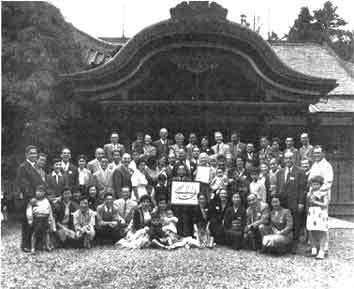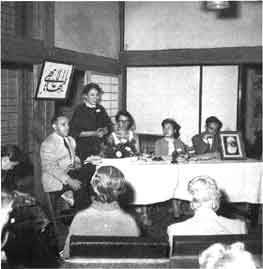
|
Traces That Remain:
A Pictorial History of the Early Days of the Bahá'í Faith among the Japanese
by Barbara R. Sims
edited by Sheridan Sims  |
chapter 54 | start page | single page | chapter 56 |  |
Chapter 55
The Asia Teaching Committee of the National Spiritual Assembly of the United States informed the Tokyo Local Spiritual Assembly that the first Asian Teaching Conference would be held in Japan. The Tokyo Local Spiritual Assembly selected the date, the location, and made all the arrangements for the conference, which became known thereafter as the "Nikko Conference."
In the Guardian's Message to the twelve national conventions that year, 1955, he reviewed some of the accomplishments of the Ten Year Crusade, and he announced that in 1957, thirteen new national assemblies were to be elected, among these would be one in Japan. It was to be a regional assembly with its seat in Tokyo. He assigned Hand of the Cause Jalal Khazeh to act as his representative at that future national convention.
There were only two local spiritual assemblies in Japan in 1955. Six more would be needed to form the basis for the national spiritual assembly. They would have to be formed by Ridván 1956 in order to elect delegates to the national convention. In addition to Japan, the regional area would consist of Korea, Taiwan, Hong Kong and Macau, so there also needed to be
In September 1955, at the close of the Nikko Conference, it seemed almost impossible to form so many more local assemblies in so short a time, but by determined teaching efforts, confirmations, even miracles, it was accomplished by April 21, 1956. Eight local spiritual assemblies were formed either by election or by joint-declaration in Japan and four other assemblies, Kwangju and Seoul in Korea, Tainan in Taiwan, and Hong Kong, were elected to make a total of twelve. All the assemblies had pioneers as members, but the majority of the Bahá'ís on the assemblies were native people of the various countries.
To go back to 1955, that year Mr. Noureddin Mumtazi

click here for larger image
In 1955 there was the first mention of the Faith in Nagasaki since the time Miss Alexander visited there in the 1930s. Miss Inatsuka of Tokyo had gone there to visit family members. Dr. and Mrs. Earl went to Nagasaki from Yamaguchi, where they were living, and joined Miss Inatsuka. She had arranged for them to meet some people to discuss the Faith. But it was not until several years later that there were enrollments in the city.
In 1955 Miss Alexander, with Mr. and Mrs. Torii, attended an Esperanto meeting in Tokushima, Shikoku Island. They then

Hand of the Cause Mr. Zikrullah Khadem, the Guardian's representative at the Nikko Conference speaking to the friends.
The same year the three of them went to Ichikawa and Fukui Prefectures for meetings of the Blind Association. Miss Alexander said her association with Esperantists and with the Blind Association offered many opportunities to speak of the Faith, often to very large groups.
In 1955 Mr. and Mrs. Aziz Mohtadi settled in Nagoya and succeeded in establishing a community which could form a local spiritual assembly the next year.
In 1956, with the needed number of local spiritual assemblies formed, and the proper number of delegates elected, the Bahá'ís looked forward to the formation of the first National Spiritual Assembly of North East Asia.

Miss Agnes Alexander at the Nikko Conference. She sent this photograph to the Guardian with these words written on the back, "Agnes roars the Cause of God!" Miss Linfoot, chairman of the conference is sitting at the table.
Mr. and Mrs. Katirai visited Awaji island, and also made several trips to the island of Shikoku, resulting in the declaration of the first Bahá'í in Takamatsu, in October 1957, an eighteen-year-old student, Teruyoshi Ando. He is not to be found today. As had happened in other places, often the early believers did not really understand the greatness of the Teachings of Bahá'u'lláh, and although they were sincere at the time, they would move, leaving no address, or simply cease activity. But then, by contrast, there were those who, knowing little, declared themselves, and through the years gained and deepened in knowledge of the Faith and remained steadfast and loyal adherents.
In the late 1950s Dr. Earl visited Sendai and other goal cities for some extension teaching.
Mr. Mumtazi, who was living in Kobe, during 1956 and 1957, went to several islands and towns; Uno Island, Te Island, Nao Island, Himeji, Okayama, Itami, Akashi and other places.
It was not easy in those days. Mr. Mumtazi wrote of his experience teaching in Akashi. He went alone, knowing no one, speaking no Japanese. He could not find any place to have meetings. He happened to meet the manager of a Buddhist Temple, Mr. Tadasu Miyazawa (see Ch. 69), who allowed him to have meetings in one of their rooms. After a year of regular meetings, several people became Bahá'ís, including Mr. Miyazawa. In 1958 an all-Japanese local spiritual assembly was formed there. It was the second all-Japanese one. Nagoya was the first, in the Ridvan 1957 election. Mr. Miyazawa remained a faithful Bahá'í until his death in 1971.
The first Japanese believer in Kobe, Mr. Rihei Sako and Mr. Mitsuteru Oka, another Kobe Bahá'í, accompanied Mr. Mumtazi on several teaching trips.
Mr. Hassan Naderi moved with his family to Osaka, in April 1956. After settling there, he became greatly discouraged as he couldn't communicate and he had no business. He bought a house in Osaka for himself and his family where all the meetings were held. Then in 1958 he donated his house to the national spiritual assembly. As is described elsewhere, that donation
In 1957 Mr. William Maxwell, the national spiritual assembly chairman, who was pioneering in Korea, made a circuit teaching trip visiting Tokyo, Akashi, Osaka, Nishinomiya,

click here for larger image
Seventeen of the nineteen Japanese Bahá'ís who attended the Nikko Conference in 1955. From the left: Miss Sadae Takeuchi, Miss Yoshiko Morita, Mrs. Suna Mori, Mr. Haruo Nekomoto, Miss Yoko Majima, Mr. Yuzo Yamaguchi, Miss Isao Sakamoto (Zenimoto), Mrs. Katsuko Ishii, Mr. Saichiro Fujita, Mrs. Kaneko Zenimoto, Mr. Takeshi Ishii, Mrs. Yuriko Furukawa, Miss Yukiko Inatsuka (Hosoda), Mr. Michitoshi Zenimoto, Miss Sumiko Nonaka, Mr. Hiroyasu Takano, Miss Kotoko Mochizuki (Honma). Missing from the photograph, but attending the conference, were Mr. Gekie Nakajima and Mr. Takeo Hasegawa.
In 1957 the Bahá'ís in Hiroshima had extension teaching activities in Kure, Iwakuni and Atsuyama.
By 1958 Mr. Labib had extended his activities to Fukuoka and Sasebo in Kyushu Island.
In those early days the Faith was spread largely through the efforts of the pioneers. As mentioned before, virtually all the Persians and Americans made periodic teaching trips to other islands or to nearby towns which were goals of the national assembly or local assemblies.

click here for larger image
Mrs. Joy Earl, early American pioneer to Japan, speaking to the conference. Seated from the left: Mr. Rouhollah Mumtazi, Miss Virginia Breaks (pioneer to the Caroline Islands), Miss Yukiko Inatsuka and Mr. Michitoshi Zenimoto.
Mr. Gekie Nakajima, an Osaka Bahá'í, also went on teaching trips; probably the most memorable was to Hokkaido in 1957 with Mr. Rouhollah Mumtazi, (see Ch. 67).
Due to the teaching efforts during the late 1950s, by 1960 there were Bahá'ís in thirty-three localities twice as many as there were in 1956.
By 1959 there were about a dozen publications in Japanese which included the revised edition of "The Hidden Words of Bahá'u'lláh" and "Bahá'u'lláh and the New Era." There was also a prayer book and several pamphlets.
A great achievement in 1959 was the purchase of a site for a future Mashriqu'l-Adkar near Tokyo. The new national spiritual assembly spent much time consulting on how to achieve the goals which had been given by the Guardian just four months before he passed away.
Hand of the Cause Zikrullah Khadem was the Guardian's representative. Miss Alexander attended in her capacity as
As it was a regional conference, Bahá'ís from the Pacific and other Far East areas were invited. About sixty adults and several children of pioneers attended. Most attendants came from Japan of course, but also as far away as Guam, Taiwan, Korea, Hong Kong, Macau, Iran and the Caroline Islands. Miss Charlotte Linfoot represented the National Spiritual Assembly of the United States, and was the conference chairman.
The conference had a two-fold purpose; first, to expedite teaching plans that would bring into existence a sufficient number of new assemblies to ensure the election of the new National Spiritual Assembly of North East Asia. The other purpose was to give impetus to the teaching in all the nearby countries.
There were many speakers at the conference. Mr. Khadem spoke on the Will and Testament and the Guardianship; Mrs. Mamie Seto on the Covenant. Miss Linfoot spoke on the goals of the Ten Year World Crusade, which was then in its second year. Mr. Hiroyasu Takano told of his pilgrimage during which the Guardian unfolded his hopes and goals for Japan. A highlight was having Mr. Saichiro Fujita tell of his years with 'Abdu'l-Bahá. Fujita was soon to leave Japan for the Holy Land at the Guardian's invitation. He stayed there, not to return to Japan again.
In September that year, there were sixty-three Bahá'ís in Japan, of whom thirty-nine were Japanese. The rest were Americans and Persians who had responded to the Guardian's call for pioneers. Special efforts were made to assist all Japanese to attend the conference. Of the thirty-nine, nineteen attended.
It was a "first" for many of the Bahá'ís attending. They had had no experience of being surrounded by Bahá'ís and living in a Bahá'í atmosphere. The loving spirit of Bahá'í brotherhood which prevailed touched the hearts.
The conference sent a greeting cable to the Guardian and received a reply before the last session. "Deeply appreciate sentiments fervently praying unprecedented victories. Deepest love, Shoghi."
The conference, and the prayer of the Guardian, did indeed bring about "unprecedented victories" and it marked a turning point for the Faith, not only in Japan, but in all of North East Asia.
 |
chapter 54 | start page | single page | chapter 56 |  |
|
|